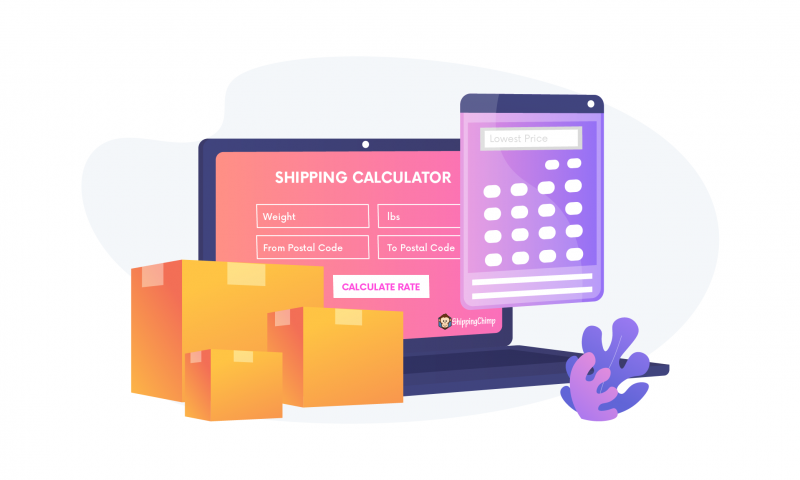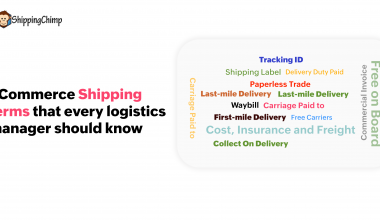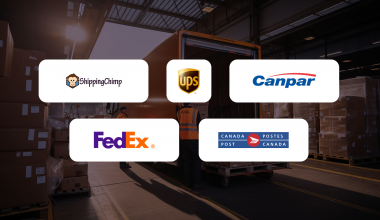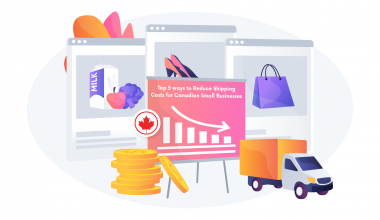Shipping matters more than ever
Shipping is more than just a final step. It’s part of your customer experience. If your rates are too high or unclear, it could be the reason people leave their carts behind. Think about it—you’ve done all the hard work getting them to buy. Don’t lose them at checkout because of surprise shipping fees.
A smooth shipping experience builds trust. When customers know what to expect, they feel confident. And when they feel confident, they come back. That’s what you want.
Why shipping costs are a big deal
You might not realize it, but shipping price can make or break a sale. A recent survey found that 64.3% of shoppers consider shipping cost one of the biggest factors when making a purchase decision. That’s huge.
So even if your products are amazing and your site is top-notch, high shipping costs could still turn people away. Getting this right isn’t just nice to have—it’s necessary.
Are you sure you’re not overspending on FedEx or UPS shipping?
If you’re offering free shipping or faster delivery, make sure those perks aren’t eating into your profits. Shipping can be one of the biggest expenses for eCommerce brands—and it adds up fast.
Between raw material shortages, delayed inventory, and carrier slowdowns, it’s easy to lose control of your costs. That’s why getting smart about your shipping strategy is so important.
Let’s break down what really goes into shipping costs and how to calculate them without losing your mind—or your margin.
What does “shipping cost” include?
Shipping costs aren’t just what you pay the courier. They include everything it takes to move an item from your warehouse to your customer’s door. That means packing materials, labour, carrier fees, and sometimes customs duties or return shipping.
Here’s a quick breakdown:
- Packaging materials: Boxes, bubble wrap, tape, labels.
- Labour: People packing and preparing shipments.
- Courier fees: Charges from carriers like UPS or Canada Post.
- Duties and taxes: For cross-border deliveries.
- Surcharges: Fuel fees or special delivery zones.
Each piece adds up. And if you don’t factor them all in, you might undercharge customers or lose money on every order.
What Brands Are Doing About Shipping Costs
A recent State of eCommerce Fulfillment Report shared how brands are managing shipping:
- 25% always offer free shipping for domestic orders
- 24% never offer free shipping
- 35% require a $50 minimum for free shipping
- 15% need customers to spend $80 for free shipping
- 28% charge a flat rate
- 13% use real-time carrier rates
Clearly, there’s no one-size-fits-all model. But every option has a cost—and understanding those costs is key.
Each brand must evaluate what makes sense for their customer base, margins, and shipping footprint. Free shipping can increase conversions, but it’s not really “free”—you’re paying for it somewhere. Understanding the numbers helps you find the sweet spot.
5 factors that determine shipping costs
Let’s take a closer look at what really goes into calculating shipping. These are the five major factors that can affect your total shipping cost—and they’re the same whether you’re sending packages within Canada or across the world.
1. Package dimensions
Carriers often charge based on something called dimensional weight. That’s a fancy way of saying they look at how big the box is, not just how heavy it is. So a large but lightweight item can cost more than a small, heavy one.
To calculate dimensional weight, multiply the package’s length, width, and height. Carriers then compare that number to the actual weight—and charge you whichever is higher. Packing efficiently helps keep these costs down.
2. Package weight
This one’s straightforward. Heavier packages cost more to ship. Make sure to weigh each package accurately before you calculate the cost. Even small errors can lead to unexpected fees.
If your products are consistently light, you may benefit from flat-rate shipping. But if they vary a lot, you’ll want to keep an eye on the scale.
3. Delivery destination
Where your customer lives makes a big difference. Shipping within a city or province is usually cheaper than shipping across Canada—and definitely cheaper than international.
Carriers use zones to calculate cost. The farther the zone, the more you pay. Also, international shipments can include customs fees, import taxes, and delays. Know what you’re getting into.
4. Delivery speed
Faster isn’t always better—at least not when it comes to cost. Offering 2-day or overnight shipping is convenient, but it comes with a premium price.
You don’t always have to offer the fastest option. Often, customers are fine with standard delivery if they know when to expect it. Be clear about timelines, and give people choices.
5. Package value
If you’re sending high-value items, you may want to add insurance. It protects you and your customer in case of loss or damage. It costs a bit more, but it could save you a lot down the road.
Many carriers offer insurance, or you can go with a third-party provider. Either way, it’s a smart move for pricier products.
How to Calculate Shipping Costs for eCommerce
Shipping costs depend on more than just the carrier. They’re affected by everything from packaging to distance to insurance.
Here’s a quick breakdown:
| Cost | Description |
|---|---|
| Carrier fees | What FedEx or UPS charges to move the package |
| Packaging | Boxes, tape, labels—everything needed to pack your order |
| Fulfillment | Labor to pick, pack, and ship your orders |
| Extras | Insurance, signatures, tracking, special handling |
| Overhead | Warehouse rent, software, printers, ink, and wages |
Let’s dive deeper into the biggest factors that impact your shipping price.
Dimensions and Weight: Why Size Matters
Both FedEx and UPS use dimensional (DIM) weight to price shipments. That means they charge based on the size of the package—not just how much it weighs.
To calculate DIM weight:
- Multiply length x width x height (in inches)
- Divide by 139 (the DIM divisor for FedEx and UPS)
Whichever is higher—DIM weight or actual weight—is the number carriers use to set the rate.
Even a light package can cost more if it’s big and bulky. Think of it like airline baggage: you’re paying for the space it takes up.
To keep costs down, consider using smaller packaging or vacuum-sealing items where possible. Optimizing packaging design isn’t just good for the environment—it’s good for your bottom line.
Calculating the DIM Weight (Source: LinkedIn.com)
- Then the shipping company calculates the cubic size of the parcel by multiplying the dimensions.
- After that, the carrier divides the package cubic size with a DIM divisor.
- Both FedEx and UPS use 139 cubic inches/pound as the DIM divisor for domestic and international shipping.
To boost the profit margin, shipping companies weigh a parcel considering its dimensions (length x width x height) instead of the actual weight.
Actual Weight: The Heavier, The Pricier
If your package weighs more than the DIM weight, that’s what gets billed. Simple as that. Heavier shipments cost more to move, especially long distances.
Heavier products may also increase handling fees. For example, FedEx has additional surcharges for packages over a certain weight or size, especially for home delivery.
Packaging Costs: It’s Not Just a Box
Customers expect fast, sleek, and secure deliveries. So your packaging has to be more than just functional—it has to impress.
Think:
- Custom boxes
- Protective padding
- Tamper-proof seals
These small upgrades add value, but they also add cost. Be sure to factor that in.
Also consider packaging automation. While an upfront investment, it can reduce long-term labor costs and increase consistency, helping to scale your shipping process.
Origin and Destination: Distance Drives Price
Shipping costs rise with distance. Carriers divide regions into zones, and the farther the zone, the more you’ll pay.
For example, FedEx and UPS both have 8 zones for ground delivery in the U.S. and Canada. A package traveling from Toronto to Vancouver will cost more than one sent within Ontario.
That’s why using multiple fulfillment centers, or working with 3PLs strategically located across the country, can reduce costs and speed up delivery.
Choose Your Location Wisely
Your origin zip code and the destination zip code matter more than you think. When you enter these into a shipping calculator, you’ll see how drastically rates change depending on the distance and delivery speed.
If your customers are concentrated in a few key regions (like Ontario, Quebec, or British Columbia), try storing inventory closer to those areas.
LTL Freight: For Larger Loads
Shipping heavy items or bulk orders? That’s where LTL freight (Less Than Truckload) comes in.
It’s more cost-effective than parcel shipping if your goods weigh over 250 lbs. But it also requires extra planning—and costs depend on the weight, space, and destination.
Make sure you:
- Get accurate weight and dimensions
- Choose the correct freight class
- Add proper labels and documentation
Mistakes here can lead to hefty adjustment charges.
Insurance: When It’s Worth It
High-value items need shipping insurance. If something gets lost or damaged, insurance covers the cost.
While it adds to your expenses, it can save you a lot if something goes wrong. This is especially true for international shipments, or when shipping items like electronics, jewelry, or food.
Many carriers offer basic coverage, but it might not be enough. Always check the fine print.
Tracking: Peace of Mind
Most major carriers include basic shipment tracking, and it’s worth offering to your customers.
It builds trust and lets you step in quickly if a delivery gets delayed or lost. You can also reduce customer service queries by keeping customers in the loop with real-time updates.
Speed: How Fast Is Too Fast?
Thanks to Amazon, customers want fast shipping—often within 1-2 days.
But offering express delivery across the board gets expensive, especially if you’re shipping from one location. Consider using it selectively for high-value customers or local zones.
You can also offer paid upgrades—many customers are willing to pay more for faster delivery if it’s clearly presented at checkout.
Unexpected Events: Budget for the Unknown
Storms. Strikes. Supply chain hiccups.
Even the best shipping plans can hit snags. Budgeting for unexpected events helps you stay ahead of the game. Always keep a little extra wiggle room in your shipping costs.
Having backup carriers or alternate delivery routes can help avoid delays. Communication is key—update your customers when delays happen.
eCommerce Shipping Cost Example
Let’s say your product costs $40 to make. Here’s a sample cost breakdown:
| Item | Cost |
|---|---|
| Product | $40.00 |
| Carrier (FedEx/UPS) | $4.50 |
| Packaging | $0.75 |
| Credit card fees | $2.00 |
| Fulfillment | $1.00 |
| Misc. (insurance, tracking, returns) | $1.50 |
| Total | $49.75 |
With a 50% profit margin, you’d set the selling price at $74.62.
Knowing your full cost breakdown helps you price confidently and maintain healthy margins.
Using Shipping Cost Calculators
Carriers like FedEx and UPS offer handy tools to help you estimate shipping rates.
FedEx Shipping Cost Calculator
FedEx calculates rates using DIM weight. They offer services like:
- Same-day
- Overnight
- Ground delivery
They also run a Small Business Program with up to 16% discounts. Use their Rate Finder Tool to check costs.
Make sure you enter accurate package information, including origin zip code, destination zip code, dimensions, and weight. The more precise the data, the more accurate your estimate.
UPS Shipping Cost Calculator
UPS offers:
- 2nd Day Air
- Ground
- 3-Day Select
Their Connect Program gives small businesses up to 20% off air/international and 10% off ground shipping. Try the UPS Calculator to get real-time pricing.
UPS also offers pickup scheduling, tracking integration, and easy label printing—all of which save time and improve delivery reliability.
ShippingChimp: Save Big on Every Shipment
At ShippingChimp, we get what Canadian D2C brands need. We help you save on shipping costs and make the process easier at every step.
Here’s what we offer:
- Up to 53% off shipping rates
- Free pickups from your location
- Real-time tracking your customers will love
- $100 free insurance on every shipment
- No volume commitment—pay only when you ship
Whether you ship 60,000 or 100,000 orders a year, we’re here to make your life easier.
Want even better rates? Try ShippingChimp—Canada’s #1 Shipping Carrier
Here’s how it works:
- Connect your store (Shopify, Magento, WooCommerce, etc.)
- Get the best shipping rates
- Print shipping labels in one click
- Track shipments and notify customers
Use the ShippingChimp calculator to start saving today.
ShippingChimp also helps you:
- Manage returns
- Offer branded tracking pages
- Reduce cart abandonment by displaying accurate rates
Final Thoughts
Shipping doesn’t have to be a black hole for your budget. By understanding the factors that affect pricing and using the right tools, you can take control of your costs—and pass on the savings to your customers.
Need help optimizing your shipping strategy? Talk to us at ShippingChimp. We’ll help you cut costs, streamline operations, and deliver a better experience every time.
Whether you’re shipping locally within Canada or shipping to the US, the right shipping strategy makes all the difference.
- Why January Is Prime Time for Carrier Contract Reviews? - January 6, 2026
- Zone Skipping 101: How Toronto Brands Ship Cheaper to Vancouver - December 31, 2025
- Why Winter Shipping Is a Big Deal for D2C Cosmetics Brands? - December 18, 2025






